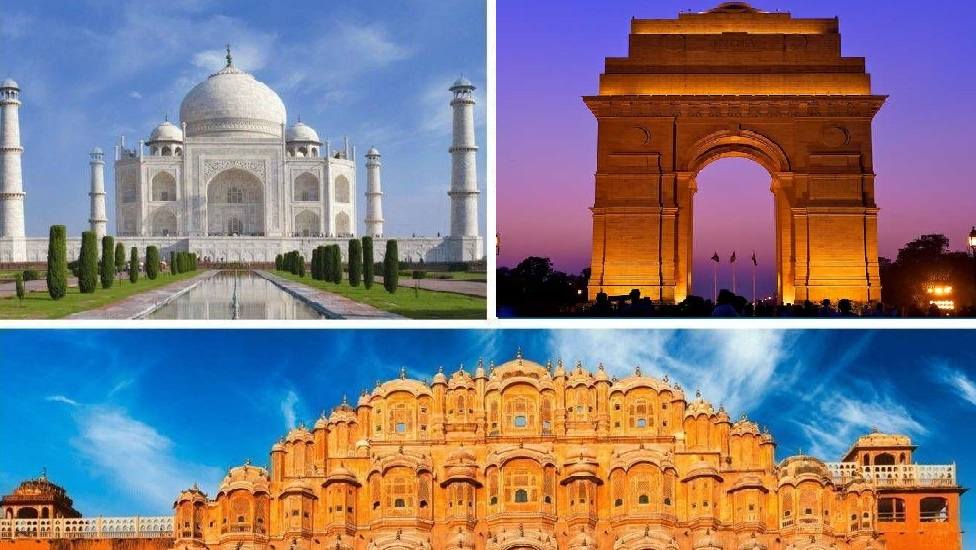The Golden Triangle Tour offers a fascinating journey through India's rich cultural tapestry, connecting Delhi, Agra, and Jaipur. This route allows foreign tourists to experience a variety of traditions, festivals, architecture, and crafts that reflect India’s diverse heritage. Each city presents unique encounters that leave a lasting impression on visitors, whether it’s the grand Mughal monuments, vibrant bazaars, or time-honored rituals. Below, we explore the cultural highlights that make this tour especially captivating for international travelers.
Discovering Delhi’s Historical and Spiritual Layers
Delhi, India’s capital, introduces travelers to a blend of ancient and contemporary cultures. The narrow lanes of Old Delhi are filled with historic treasures such as Jama Masjid and Chandni Chowk. Many tourists enjoy exploring these on foot or by rickshaw to get an authentic feel of daily life. The Red Fort’s evening light and sound show narrates Delhi’s history with dramatic flair, offering foreign guests an engaging storytelling experience.
At the same time, sites like the Lotus Temple and Akshardham reflect India’s spiritual diversity. Foreign visitors often find these places peaceful and enlightening. Participating in a traditional langar (community meal) at Gurudwara Bangla Sahib provides insight into Sikh hospitality and values. Delhi’s museums, like the National Handicrafts and Handlooms Museum, give travelers a deeper understanding of India’s artistic legacy.
Experiencing Mughal Grandeur in Agra
Agra’s cultural identity is inseparable from its Mughal heritage. While the Golden Triangle Tour With Ranthambore itinerary enhances the adventure with wildlife exploration, Agra itself offers immersion in architectural marvels. The Taj Mahal, with its poetic symmetry and detailed craftsmanship, represents not just love but the artistic excellence of the Mughal era. Visitors often time their visit at sunrise or sunset for breathtaking views that photographers particularly treasure.
Agra Fort, another UNESCO World Heritage Site, provides context to Mughal life and governance. Foreign tourists often appreciate guided tours here to better grasp its historical significance. Mehtab Bagh, located across the Yamuna River, is a quieter spot where travelers can enjoy panoramic views of the Taj Mahal amidst serene gardens.
Beyond monuments, Agra’s marble workshops, where artisans demonstrate traditional inlay work, give travelers a chance to witness centuries-old skills still practiced today. Many foreign visitors enjoy browsing the local markets for handicrafts inspired by Mughal designs.
Jaipur’s Royal Traditions and Vibrant Arts
Jaipur, the Pink City, completes the cultural arc of the Golden Triangle. Foreign tourists are drawn to its colorful streets, ornate palaces, and lively festivals. Amber Fort, with its hilltop views and detailed mirror work, is a highlight. Visitors can explore its courtyards, halls, and temples while learning about Rajput history through guided narratives.
City Palace and Jantar Mantar reveal Jaipur’s royal and scientific heritage. For many foreign travelers, joining a block-printing or miniature painting workshop in the city provides hands-on cultural learning. Jaipur’s bustling bazaars—like Johari Bazaar and Bapu Bazaar—are favorite stops for experiencing local life and picking up souvenirs such as textiles, jewelry, and pottery.
Cultural performances, including folk dances and puppet shows, are often arranged at heritage venues. These offer tourists insight into Rajasthan’s vibrant traditions in a festive atmosphere.
Extended Cultural Discoveries
For foreign visitors seeking to go beyond the classic route, a Golden Triangle Tour with Varanasi adds a spiritual dimension. Varanasi, regarded as one of the oldest living cities, introduces travelers to age-old rituals along the Ganges. The Ganga Aarti at Dashashwamedh Ghat is a mesmerizing spectacle of lights, chants, and devotion that leaves a deep impression on those witnessing it for the first time.
Similarly, choosing a Golden Triangle Tour With Ranthambore allows tourists to experience the unique culture of rural Rajasthan. Beyond the thrill of tiger safaris, visitors can explore village life, interact with local communities, and observe traditional crafts like pottery and weaving. These encounters provide meaningful connections that many international travelers cherish as the most memorable part of their journey.
Culinary Culture Along the Route
Culinary experiences form an integral part of the cultural journey through the Golden Triangle. From Delhi’s street food, like chaat and parathas, to Agra’s sweet pethas, and Jaipur’s spicy curries and sweets, food serves as a delicious gateway to local traditions. Cooking classes and food walks have become popular among foreign tourists, providing them with the chance to learn recipes and kitchen techniques that they can take home.
Each city offers regional flavors influenced by history, climate, and community practices. For many visitors, sharing meals with local families or dining at traditional eateries adds warmth and authenticity to their cultural exploration.
Final Thoughts
The Golden Triangle route offers a rich variety of cultural experiences that appeal to foreign travelers seeking meaningful connections with India’s heritage. From grand monuments and spiritual sites to folk arts, crafts, and cuisine, each stop on the journey opens a new window into India’s vibrant identity. Whether travelers choose the classic Golden Triangle Tour or extend their adventure with destinations like Ranthambore or Varanasi, the cultural encounters along the way leave lasting memories and deeper appreciation for India’s diversity.
